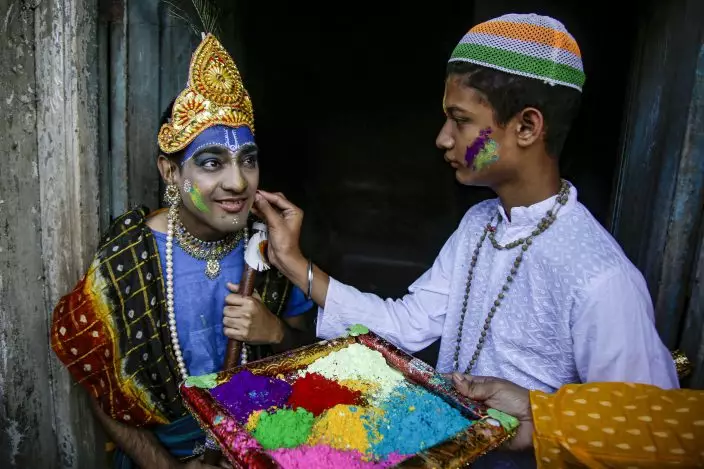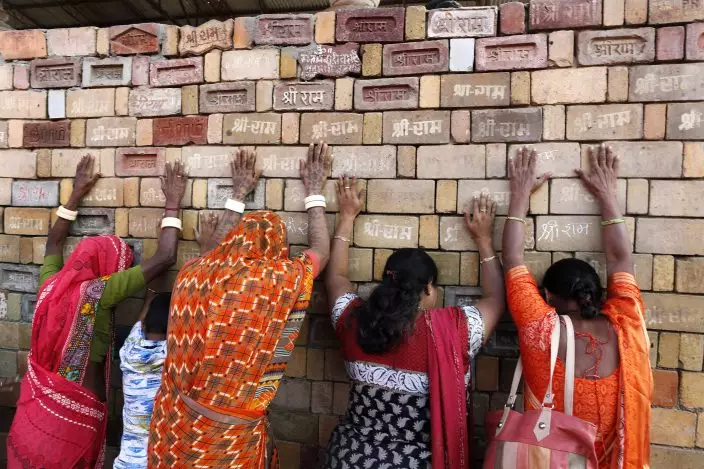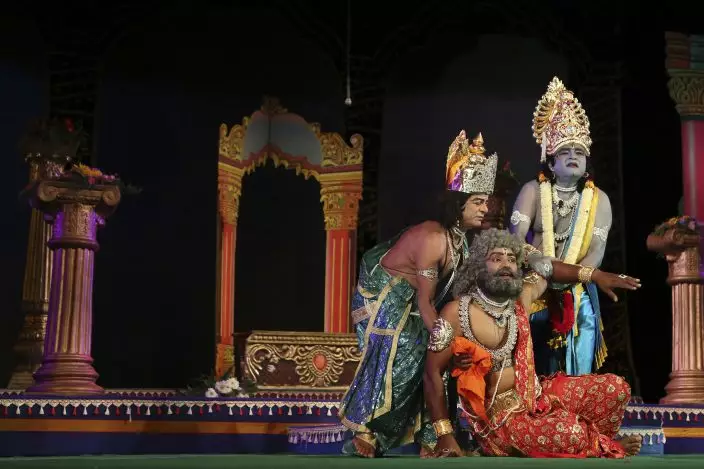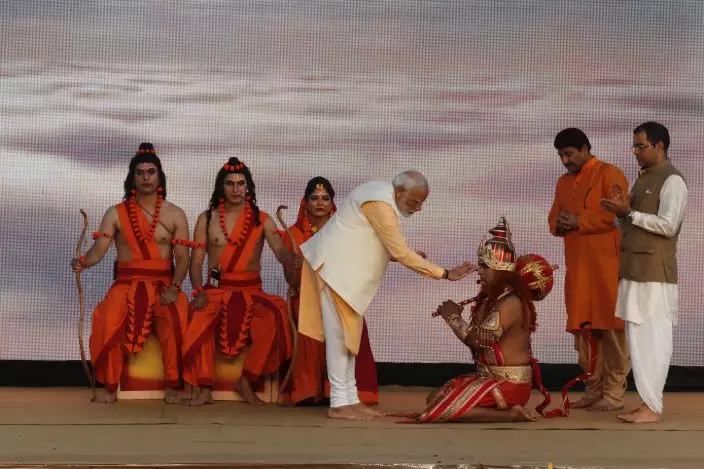Staying home under lockdown as they wait for the worst of the coronavirus pandemic to pass, millions of Indians are turning to their gods. Not in prayer rooms, but on TV.
Seeking comfort in the certainty of the past, Indians are devouring reruns of popular Hindu religious dramas. They're drawing on shared experiences of Indian mythology, which is replete with tales of moral and ethical choices in times of crises and invokes the virtues of individual sacrifice for social good.
The country’s public broadcaster has revived epic television shows like “Ramayan” and “Shri Krishna ” – both highly revered mythological tales – and has been rebroadcasting them at prime time every day.

FILE- In this March 7, 2020, file photo, a school boy dressed as Hindu mythological character Krishna has colored powder applied on his face to celebrate the spring festival of Holi, the festival of colors, in Kolkata, India. Seeking comfort in the certainty of the past, Indians are tuning into re-runs of popular Hindu religious dramas, drawing on shared experiences of old times when most questions had answers. Staying home under a lockdown as they wait for the worst of the coronavirus pandemic to pass, millions of Indians are turning to their Gods. Not in their prayer rooms, but on their televisions. (AP PhotoBikas Das, File)
“Shri Krishna," a TV series originally broadcast in 1993, is an adaptation of life of one of Hinduism’s most popular gods.
In “Ramayan,” a wildly popular series from the '80s, filmmaker Ramanand Sagar tells the story of Lord Ram, the prince of Ayodhya, who was sent into exile for 14 years and rescued his kidnapped wife Sita from the demon Ravan.
“When the show was first telecast, the streets used to be completely deserted and everyone watched it with devotion. The stories about the victory of good over evil were very engaging, ” said Vijay Kumar Jain, a physician and gastroenterologist practicing in New Delhi and an avid fan of the dramas.

FILE- In this Nov. 11, 2019, file photo, Hindu women devotees pray to the bricks reading "Shree Ram" (Lord Ram), which are expected to be used in constructing Ram temple, in Ayodhya, India. A court verdict last year paved the way for building a grand Ram temple on a site in northern India where Hindu hard-liners had demolished a 16th century mosque in 1992, sparking deadly religious riots. But faith in the deity as a symbol of virtue and moral authority transcends the politics of strident Hindu nationalism, with millions of moderate, practicing Hindus keeping idols of Ram in their homes for daily worship. (AP PhotoRajesh Kumar Singh, File)
On April 16, the show had a record 77 million viewers, India’s public broadcaster Prasar Bharati tweeted.
“In this era of crisp and Gen Z content, these figures clearly indicate that there is still demand for values and ethos driven content in the world’s largest democracy," Prasar Bharti said in a press release.
Meanwhile, on the streets, an epic but tragic drama of another kind is playing out.

FILE- In this Nov. 2, 2015, file photo, Indian actors dressed as Rama, right, Dasharatha, center, and Laxman, the characters of Hindu epic Ramayana perform at a theatre in Bangalore, India. Seeking comfort in the certainty of the past, Indians are tuning into re-runs of popular Hindu religious dramas, drawing on shared experiences of old times when most questions had answers. Staying home under a lockdown as they wait for the worst of the coronavirus pandemic to pass, millions of Indians are turning to their Gods. Not in their prayer rooms, but on their televisions. (AP PhotoAijaz Rahi, File)
Millions of poor migrant workers, hungry and in despair, are walking from cities to their villages after the lockdown took away their jobs and left them to fend for themselves.
As the COVID-19 caseload in India surges past 100,000, the economy is beginning to reopen with some restrictions. But the anxiety over what lies ahead is running high.
"Showing majoritarian mythologicals when a diverse country faces a human crisis of unparalleled scale may create an illusion of wellness," filmmaker Dibakar Banerjee wrote in the Indian express newspaper.

FILE - In this Oct. 8, 2019, file photo, Indian Prime Minister Narendra Modi applies vermilion on the forehead of an artist dressed as Hindu monkey god Hanuman, watched by artists dressed as Rama, his brother Lakshman and wife Sita, at an event marking the end of Dussehra festival in New Delhi, India. Seeking comfort in the certainty of the past, Indians are devouring reruns of popular Hindu religious dramas as the country’s public broadcaster has revived epic television shows like “Ramayan,” the story of Lord Ram who was sent into exile for 14 years and rescued his kidnapped wife Sita from the demon Ravan, and “Shri Krishna," both highly revered mythological tales. On April 16, 2020, the show had a record 77 million viewers, India’s public broadcaster Prasar Bharati tweeted. Prime Minister Narendra Modi has often invoked Hindu scriptures in his speeches during the lockdown, asking people to do their duty and follow social distancing rules to win the battle against COVID-19. (AP PhotoManish Swarup, File)
“In the midst of a pandemic that levels all, the chosen and the downtrodden, many of us fantasize about a return to a golden, simple past," he wrote.
Prime Minister Narendra Modi has often invoked Hindu scriptures in his speeches during the lockdown, asking people to do their duty and follow social distancing rules to win the battle against COVID-19.
“There is no bigger force than our enthusiasm and conviction. There is nothing we can’t achieve,” he said in his national address on April 3 , taking inspiration from a verse in the Hindu epic Ramayan.

FILE- In this Oct. 8, 2019, file photo, Indian Defense Minister Rajnath Singh writes onto a Rafale jet fighter as a ritual gesture during an handover ceremony at the Dassault Aviation plant in Merignac, near Bordeaux, southwestern France. In India, the relationship between faith and science is complicated. Seeking comfort in the certainty of the past, Indians are tuning into re-runs of popular Hindu religious dramas, drawing on shared experiences of old times when most questions had answers. (AP PhotoBob Edme, File)
A court verdict last year paved the way for building a grand Ram temple on a site in northern India where Hindu hard-liners demolished a 16th-century mosque in 1992, sparking deadly religious riots.
But faith transcends the politics of strident Hindu nationalism, and millions of moderate, practicing Hindus keep idols of Ram in their homes for daily prayer.
“In today’s uncertain times, people are trying to make sense of their lives - who am I, what is my place in the universe. And mythology offers us truth and wisdom,“ said Jain.


